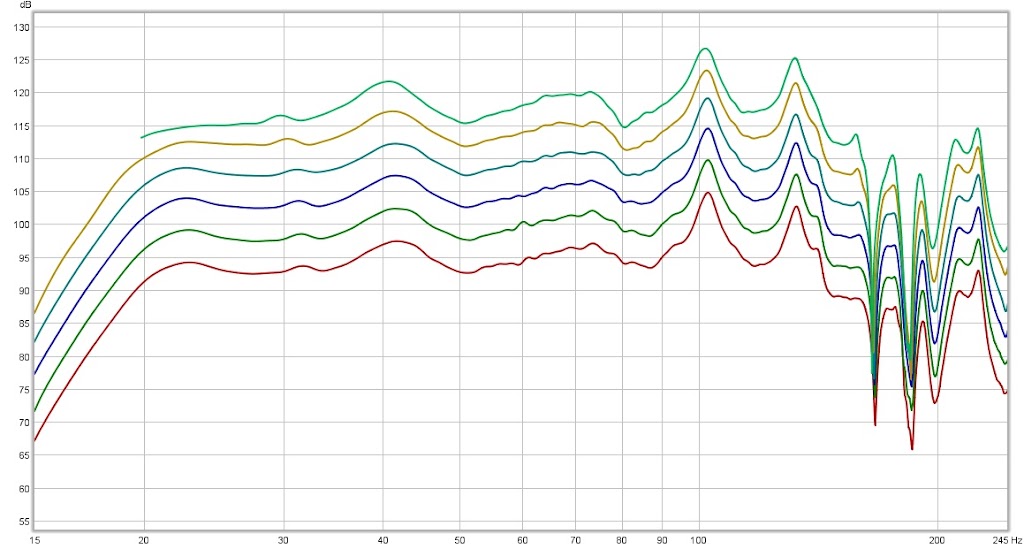Consider this:
DIY Sound Group
In something like this:
Slot-loaded sealed subwoofer (magnet facing into slot)
Vr=57 litres
Vf=22.5 litres
Slot area = 860 cm^2
HornResp predicts 95dB/2.83V/1M, and 90dB/2.83V/1M @40 Hz, in a 2.8 cu.ft. (net) box. with about 117dB peak before Xmax is exceeded.
Here's the thing - the driver is only $77, so you could buy FOUR and series-parallel them to get 101dB/2.83V/1M in a 11.3 cu.ft. (net) box and over 130dB into 2PI space with about 2.5kW of power.
DIY Sound Group
In something like this:
Slot-loaded sealed subwoofer (magnet facing into slot)
Vr=57 litres
Vf=22.5 litres
Slot area = 860 cm^2
HornResp predicts 95dB/2.83V/1M, and 90dB/2.83V/1M @40 Hz, in a 2.8 cu.ft. (net) box. with about 117dB peak before Xmax is exceeded.
Here's the thing - the driver is only $77, so you could buy FOUR and series-parallel them to get 101dB/2.83V/1M in a 11.3 cu.ft. (net) box and over 130dB into 2PI space with about 2.5kW of power.
Is there any information about its power compression figures?Here's the thing - the driver is only $77, so you could buy FOUR and series-parallel them to get 101dB/2.83V/1M in a 11.3 cu.ft. (net) box and over 130dB into 2PI space with about 2.5kW of power.
In the F-20 design/build thread, I measured the completed project at 1 watt, then added 5 dB and re-swept until I ran out of amp at +25 dB (~315 watts).
Here is the chart I presented.

We saw a bit of compression in the last sweep, which was at the limit of the amplifier and at close to 90 watts over the drivers' thermal rating. I'm not sure which contributed more. I was also driving the coil out of the gap - that may be part of what we saw too.
Sweeps were approximately a minute apart, just enough time to process the FFTs and increase the signal level.
I'm pretty sure that 300 to 500 watts is a fair limit. 625 (2500/4) is probably too much power for the coil to handle.
Here is the chart I presented.

We saw a bit of compression in the last sweep, which was at the limit of the amplifier and at close to 90 watts over the drivers' thermal rating. I'm not sure which contributed more. I was also driving the coil out of the gap - that may be part of what we saw too.
Sweeps were approximately a minute apart, just enough time to process the FFTs and increase the signal level.
I'm pretty sure that 300 to 500 watts is a fair limit. 625 (2500/4) is probably too much power for the coil to handle.
Last edited:
Not exactly sure what you mean.
It is my understanding that power compression is usually measured and calculated similarly. Illka has provided many tests with similar sweeps, as have many others. My presentation is simply SPL sweeps, I have not "done the math" to calculate power compression numbers.
Really, all I wanted to show is a measurement of this driver in a cabinet (admittedly completely unrelated to the OP's interesting design) that shows additional power in does not equal a proportionate increase in SPL out once the driver's limits are reached.
It is my understanding that power compression is usually measured and calculated similarly. Illka has provided many tests with similar sweeps, as have many others. My presentation is simply SPL sweeps, I have not "done the math" to calculate power compression numbers.
Really, all I wanted to show is a measurement of this driver in a cabinet (admittedly completely unrelated to the OP's interesting design) that shows additional power in does not equal a proportionate increase in SPL out once the driver's limits are reached.
Last edited:
Ever measurement is appreciatedReally, all I wanted to show is a measurement of this driver in a cabinet (admittedly completely unrelated to the OP's interesting design) that shows additional power in does not equal a proportionate increase in SPL out once the driver's limits are reached.
 and yes every driver will have a point where power doesn’t translate in the same SPL rise any longer (lower than 50% of the BL)
and yes every driver will have a point where power doesn’t translate in the same SPL rise any longer (lower than 50% of the BL) Measuring with sine-waves (non-complex-signal) wont deliver the whole story. You need long time noise signal measurements for power compression. A Noise signal because it is a complex signal like music and long time (>20minutes) because it will create heat like under working conditions.Not exactly sure what you mean.
It is my understanding that power compression is usually measured and calculated similarly. Illka has provided many tests with similar sweeps, as have many others. My presentation is simply SPL sweeps, I have not "done the math" to calculate power compression numbers.
You can divide power compression in two basic processes;
1.) Dynamic Compression, which is the result of mechanical forces created by suspension. The further the excursion the more force is needed.
2.) Thermal Compression, which is the result of heat development in and around the voice coil trough electric resistance and mechanical resistance.
- Status
- This old topic is closed. If you want to reopen this topic, contact a moderator using the "Report Post" button.
- Home
- Loudspeakers
- Subwoofers
- Thoughts......?